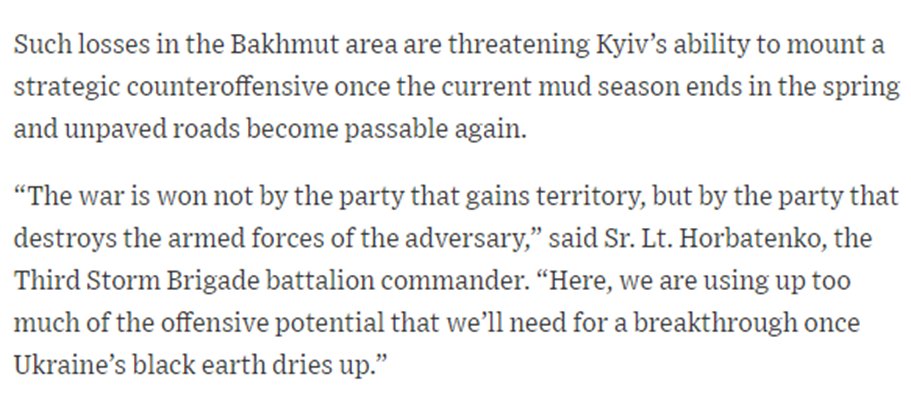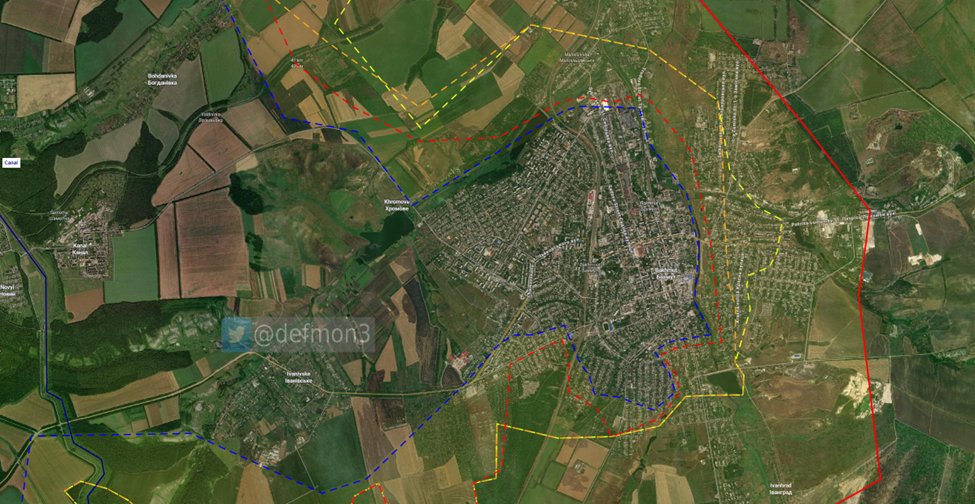Thread on Bakhmut. Before talking about the tactical situation, it is important to put it in the strategic context. Ukraine conducted successful offensives in Kharkiv and Kherson after heavy Russian military attrition during the Battle of the Donbas left its lines vulnerable.
Russia's successful withdrawal from the right bank of Kherson and mobilization helped stabilize the lines and stopped Ukraine's advance to Kreminna. In order to make further serious gains, Ukraine went on the defense to buy time to form new units/train on NATO equipment.
The battle in Bakhmut began more than 6 months ago, but became a focus over the winter as both sides redeployed forces to Bakhmut from Kherson. Bakhmut thereby acquired a degree of political significance on both sides.
Russia began its winter offensive in late January. Russian forces have attempted to advance in several parts of the front while making minimal gains. In some areas like Vuhledar, Russian forces have suffered far heavier losses than Ukrainian forces.
https://mobile.twitter.com/RALee85/status/1618685215425302528
Russia has also sustained heavy losses in Bakhmut, but the ratio of losses shifted as Russia took the flanks (which sit on high ground), beginning with the southern flank in January and the northern flank in mid/late-February including Yahidne on the 25th.
https://twitter.com/War_Mapper/status/1634593338161496067
Although the center of Bakhmut has strong buildings and factories, the flanks are composed of houses without basements. Once they're targeted, they're no longer useful as fighting positions. Russian advances on the flanks put the main resupply routes within direct-fire range.
Newly mobilized soldiers are being sent to Bakhmut as combat replacements and the units don't have enough time to train them properly. There is a trade-off between sending mobilized soldiers to the front or to new units preparing for the spring offensive. kyivindependent.com/national/ukrai…
Although there was a 3-week period in which Russian artillery fire was reduced, it increased at the end of February as the 106th Airborne Division played a greater role, which coincided with greater Wagner-VDV cooperation. Russia has a substantial artillery advantage in Bakhmut.
Wagner commanders are given greater discretion and flexibility to fight as they see fit and to find/exploit weak points (TDF units are often deliberately targeted). Some Wagner units operate at night while others only during the day. Wagner convicts are not allowed to retreat.
Bakhmut matters to Russia because its stated goal is to seize all of the Donbas, but Russian forces are struggling to advance towards Kramatorsk-Slovyansk from the other directions. It has also been key to Ukraine’s defense of the rest of the Donbas.
Ukraine is prioritizing forming and training new units in three army corps for its spring offensive while trying to hold the entirety of the front line. But those are competing priorities, and Ukraine is deliberately holding back reserves. economist.com/zaluzhny-trans… 

This may give the impression that Ukraine is losing, but, in reality, Ukraine is not committing all of its resources to the front. Ukraine has a better chance of achieving another significant breakthrough this spring than Russia does during its current offensive.
Russia is dependent on a small number of elite units for their assaults (e.g. naval infantry, VDV, Wagner professionals), but they can grind their way to slow, costly victories by employing greater forces and artillery. An attritional fight is not in Ukraine’s interests.
Until its offensive, Ukraine's best strategy is to pick battles where it can achieve a favorable ratio of attrition and expend fewer munitions, which could weaken Russian forces' ability to defend without significantly sapping Ukraine's offensive potential in the coming months.
Although the attrition ratio in Bakhmut has been advantageous for the duration of the battle, the ratio is much less favorable now with Ru forces holding high ground on the city's flanks. Much of Russia's losses are prisoners of less military value than Ukrainian soldiers.
In contrast, in Vuhledar, the share of Russian casualties from elite units is higher than in Bakhmut, and it isn't clear if Wagner's use of convicts would be as effective in a less urban setting.
The upcoming Ukrainian offensive will be strategically critical and potentially decisive. Western aid, including ammunition, will likely peak this spring and summer, and it will take years before increases in artillery production capacity can be achieved.
Ukraine will not have air superiority, will face stronger Russian defenses than it did in Kharkiv, and will likely only be able to achieve localized superiority in artillery fire and forces. To gives its offensive the best chance for success, Kyiv needs to husband its resources.
There is no risk-free option for Ukraine. Retrograde operations are dangerous, withdrawing from Bakhmut could lead to more pressure on Siversk or elsewhere, and there is no guarantee Ukraine would be able to retake the city later if it withdraws.
But there is a risk that, by committing the necessary forces to continue holding Bakhmut (where its attrition ratio isn't favorable), Ukraine will sap some of the forces available for its strategically more important spring offensive. wsj.com/amp/articles/r… 

Another risk is that Russian forces will continue to press to the west to try to seize high ground north of Chasiv Yar, which is defensible terrain for holding Kramatorsk and Slovyansk. Encirclement is also a risk. 

https://twitter.com/DefMon3/status/1637538033921851392


Encircling Bakhmut is Russia's best opportunity to inflict a serious defeat on Ukraine. The VDV's 106th Airborne Division has taken on a greater role, and the Russian MoD will likely prioritize cutting off the remaining MRSs by committing more resources.
https://twitter.com/wartranslated/status/1632774531650576385
The mud season has now begun, which could complicate a withdrawal or reinforcement, particularly if Russian forces advance closer to the O0506 hardball road. This could limit the use of wheeled vehicles.
As in Mariupol and countless other battles, Ukrainian forces have defended bravely and inflicted heavy losses on Russian forces in Bakhmut, which will likely aid Ukraine’s spring offensive. But the conditions have worsened over the past month.
What should Ukraine do? I don’t know. It isn’t a black and white issue and there is uncertainty. Russia may overextend itself trying to take the city and leave itself vulnerable to counterattack. It is ultimately a question of where Ukraine chooses to assume risk.
Just as the strategic consequences of Russia's offensive in the Donbas in the spring and summer wasn't fully clear until after Ukraine's offensives in the fall, it probably won't be clear whether the continued defense of Bakhmut was the right move until after Ukraine's offensive.
• • •
Missing some Tweet in this thread? You can try to
force a refresh




















